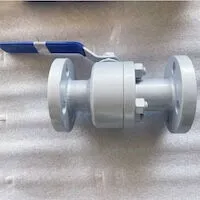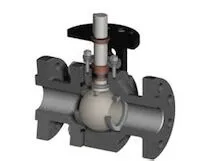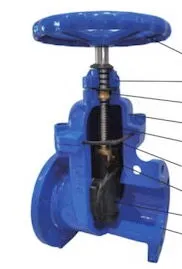Valves Used for Large Seawater Desalination Projects
May 27, 2023
The particularity of process medium, corrosion factors and working conditions in seawater desalination projects is introduced, and the commonly used materials for seawater desalination project valves and the structure types, installation methods and selection principles of large-diameter butterfly valves and check valves are discussed in this article.
1. Overview
In recent years, with the improvement of people's living standards and industrial development, the consumption of fresh water has increased year by year. To solve the problem of water, many large-scale seawater desalination projects are under construction in China. The selection of process valves in the engineering design process of seawater desalination projects from the aspects of media, materials, anti-corrosion treatment, structure and installation requirements is analyzed.
2. Process media
In the process of seawater desalination, special attention should be paid to the corrosion of equipment by chlorides. In addition, seawater temperature has a great influence on the corrosion rate, the higher the temperature is, the faster the corrosion becomes. Solid pollutants can damage the protective film of the material and cause corrosion. Various chemical pollutants also increase the probability of corrosion. Batching additives may be an anthropogenic marine chemical pollutant, but moderate amounts should not cause any problems from a corrosion standpoint. For example, sodium hypochlorite is sometimes used to inhibit algae, but too much amount can cause severe pitting corrosion. There are various processes for the desalination of seawater, among which the main process of reverse osmosis technology is seawater intake→pretreatment→ultrafiltration→reverse osmosis→product water (by-product reverse osmosis liquid), and the composition of the main medium in each process is shown in Table 1. The composition of seawater varies from place to place.
3. Materials of valves
In seawater desalination projects, problems with valve materials often occur on flow-passing parts. At present, the commonly used materials for flow-passing components mainly include nickel-aluminum bronze, stainless steel, duplex stainless steel, and metal coating.
4. Installation of valves
4.1. General requirements
Valves should be set according to the type and quantity shown on the Piping and Instrumentation Diagram (P&ID). When the system has specific requirements for the installation position of some valves, it should be set according to the process requirements. The installation position of the valve should be centrally arranged on one side of the device area, and the necessary operating platform or maintenance platform should be set up. Valves that require frequent operation, maintenance and replacement should be located on the ground, on platforms, or easily accessible by ladders. The height of the center of the valve handwheel from the operating surface is between 750 and 1500mm; the most suitable height is 1200mm, and the installation height of valves that do not require frequent operations can reach 1500 to 1800mm. The valve should keep an appropriate distance from the dosing port to avoid severe pitting corrosion caused by too great partial medicament performance.
4.2. Large valves
The body load of large valves is great, and the piping should be arranged horizontally and supported independently. Considering the operation and maintenance space of the transmission mechanism, brackets should also be set on one or both sides of the valve. The support should not be set on the short pipe that needs to be disassembled during maintenance, and the support of the pipe should not be affected when the valve is removed; the support should be 50 to 100mm above the ground. When the actuator is heavy, separate support is required.
The installation of the butterfly valve is determined according to the pipeline layout. When the pipeline is arranged horizontally, the butterfly valve stem should be arranged as horizontally as possible, and the opening direction of the butterfly valve must be consistent with the flow direction of the medium to prevent the slurry and pollutants in the medium from depositing on the sealing parts of the valve shaft and the valve body. When the valve is opened, the working torque is small, and it plays a certain role in pipeline dredging.
The wafer check valve is arranged at the outlet of the seawater pump, provided by a shut-off valve. To avoid collision and interference of the valve discs of the two wafer check valves, a straight pipe section shall be provided between the two valves. The length of the straight pipe section is between 1.5 to 2.0. If a horizontally arranged fully rubber-lined butterfly wafer check valve is used, the valve stem needs to be installed vertically, which can prolong the service life of the valve. If a single-disc wafer check valve or a single-disc bi-directional steel wafer check valve is used, the installation direction of the valve should be conducive to the direction of gravity closing.
5. Conclusion
When selecting valves for seawater desalination projects, it is necessary to analyze the flow medium, corrosion factors, material selection, structure and installation of the valves, and then conduct economic and technical comparisons and selections.
(1) When selecting materials for valves, it is necessary to start with the analysis of the flow medium in the working condition, find out the main factors, and choose reasonable materials according to the characteristics of the medium and the process requirements.
(2) When selecting the structure of the valve, it is necessary to make a technical and economic comparison of the consumables, space, energy consumption and cost of the valve, and select products with low consumables, low energy consumption and low noise.
(3) To avoid shortening the service life and affecting system operation caused by improper valve installation, the engineering design should meet the valve installation requirements to ensure that the equipment operates in a reasonable state and is suitable for the pipeline or equipment to bear the load of the valve.
1. Overview
In recent years, with the improvement of people's living standards and industrial development, the consumption of fresh water has increased year by year. To solve the problem of water, many large-scale seawater desalination projects are under construction in China. The selection of process valves in the engineering design process of seawater desalination projects from the aspects of media, materials, anti-corrosion treatment, structure and installation requirements is analyzed.
2. Process media
In the process of seawater desalination, special attention should be paid to the corrosion of equipment by chlorides. In addition, seawater temperature has a great influence on the corrosion rate, the higher the temperature is, the faster the corrosion becomes. Solid pollutants can damage the protective film of the material and cause corrosion. Various chemical pollutants also increase the probability of corrosion. Batching additives may be an anthropogenic marine chemical pollutant, but moderate amounts should not cause any problems from a corrosion standpoint. For example, sodium hypochlorite is sometimes used to inhibit algae, but too much amount can cause severe pitting corrosion. There are various processes for the desalination of seawater, among which the main process of reverse osmosis technology is seawater intake→pretreatment→ultrafiltration→reverse osmosis→product water (by-product reverse osmosis liquid), and the composition of the main medium in each process is shown in Table 1. The composition of seawater varies from place to place.
3. Materials of valves
In seawater desalination projects, problems with valve materials often occur on flow-passing parts. At present, the commonly used materials for flow-passing components mainly include nickel-aluminum bronze, stainless steel, duplex stainless steel, and metal coating.
4. Installation of valves
4.1. General requirements
Valves should be set according to the type and quantity shown on the Piping and Instrumentation Diagram (P&ID). When the system has specific requirements for the installation position of some valves, it should be set according to the process requirements. The installation position of the valve should be centrally arranged on one side of the device area, and the necessary operating platform or maintenance platform should be set up. Valves that require frequent operation, maintenance and replacement should be located on the ground, on platforms, or easily accessible by ladders. The height of the center of the valve handwheel from the operating surface is between 750 and 1500mm; the most suitable height is 1200mm, and the installation height of valves that do not require frequent operations can reach 1500 to 1800mm. The valve should keep an appropriate distance from the dosing port to avoid severe pitting corrosion caused by too great partial medicament performance.
4.2. Large valves
The body load of large valves is great, and the piping should be arranged horizontally and supported independently. Considering the operation and maintenance space of the transmission mechanism, brackets should also be set on one or both sides of the valve. The support should not be set on the short pipe that needs to be disassembled during maintenance, and the support of the pipe should not be affected when the valve is removed; the support should be 50 to 100mm above the ground. When the actuator is heavy, separate support is required.
The installation of the butterfly valve is determined according to the pipeline layout. When the pipeline is arranged horizontally, the butterfly valve stem should be arranged as horizontally as possible, and the opening direction of the butterfly valve must be consistent with the flow direction of the medium to prevent the slurry and pollutants in the medium from depositing on the sealing parts of the valve shaft and the valve body. When the valve is opened, the working torque is small, and it plays a certain role in pipeline dredging.
The wafer check valve is arranged at the outlet of the seawater pump, provided by a shut-off valve. To avoid collision and interference of the valve discs of the two wafer check valves, a straight pipe section shall be provided between the two valves. The length of the straight pipe section is between 1.5 to 2.0. If a horizontally arranged fully rubber-lined butterfly wafer check valve is used, the valve stem needs to be installed vertically, which can prolong the service life of the valve. If a single-disc wafer check valve or a single-disc bi-directional steel wafer check valve is used, the installation direction of the valve should be conducive to the direction of gravity closing.
5. Conclusion
When selecting valves for seawater desalination projects, it is necessary to analyze the flow medium, corrosion factors, material selection, structure and installation of the valves, and then conduct economic and technical comparisons and selections.
(1) When selecting materials for valves, it is necessary to start with the analysis of the flow medium in the working condition, find out the main factors, and choose reasonable materials according to the characteristics of the medium and the process requirements.
(2) When selecting the structure of the valve, it is necessary to make a technical and economic comparison of the consumables, space, energy consumption and cost of the valve, and select products with low consumables, low energy consumption and low noise.
(3) To avoid shortening the service life and affecting system operation caused by improper valve installation, the engineering design should meet the valve installation requirements to ensure that the equipment operates in a reasonable state and is suitable for the pipeline or equipment to bear the load of the valve.
Previous: Maintenance and Repair During Valve Operation
Next: 11th Shanghai International Pump and Valve Exhibition


